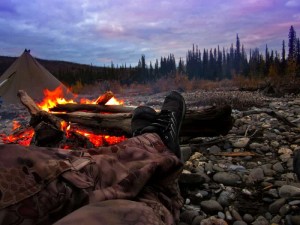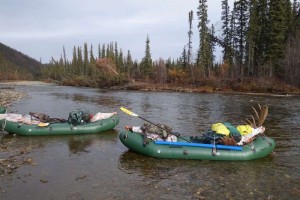 A particularly cold September’s morning found my friend I preparing for another Alaskan float hunt. We were breaking down our camp and readying ourselves for an early morning decent downstream. Our plan was to begin floating at the first hint of daybreak, which meant a 4:30 a.m. wakeup call. The brisk morning air chilled our bodies to the bone. And as the heavy dew became frost, seemingly before our eyes, we could almost hear the transformation.
A particularly cold September’s morning found my friend I preparing for another Alaskan float hunt. We were breaking down our camp and readying ourselves for an early morning decent downstream. Our plan was to begin floating at the first hint of daybreak, which meant a 4:30 a.m. wakeup call. The brisk morning air chilled our bodies to the bone. And as the heavy dew became frost, seemingly before our eyes, we could almost hear the transformation.
The pungent smell of the fallen deciduous leaves served as a reminder that winter’s harsh bite was drawing near. I love fall mornings such as this one, as they bring me closer to my senses. My mind becomes clear and sharper than ever; and hunting ol’ Alces gigas demands such fine-tuning of awareness. I can think of no better way to experience an Alaskan hunt than floating serenely down a river within the heart of prime moose habitat. My comrade and I were jubilant, as we were to duplicate that morning ten-fold before exiting that river adventure.
 I began to wonder why we were seeing few other hunters, as this remote experience was most certainly affordable. Why other sportsmen are still pursuing other means of hunting is beyond me. I enjoy the closeness with Nature, not provided with the use of gasoline powered vessels. Somehow the smell of exhaust, the scream of engines, and the impact on the environment detracts from the whole experience. If you’re one who is searching for a true adventure and open-minded to a pristine river float, you are in just the right place to pursue such an experience. Finding a river to float hunt is the easy part, just ask a friend where they have hunted. I’m sure a river name will rise to the surface of the conversation. However, before embarking upon your river float, there are a few important factors to consider.
I began to wonder why we were seeing few other hunters, as this remote experience was most certainly affordable. Why other sportsmen are still pursuing other means of hunting is beyond me. I enjoy the closeness with Nature, not provided with the use of gasoline powered vessels. Somehow the smell of exhaust, the scream of engines, and the impact on the environment detracts from the whole experience. If you’re one who is searching for a true adventure and open-minded to a pristine river float, you are in just the right place to pursue such an experience. Finding a river to float hunt is the easy part, just ask a friend where they have hunted. I’m sure a river name will rise to the surface of the conversation. However, before embarking upon your river float, there are a few important factors to consider.
Know the Area
- Contact land managers of the river you intend to float. For the proper land managers, contact the Bureau of Land Management in Fairbanks (907) 474-2200 or Anchorage (907) 271-5960,
- Purchase topographical maps of the area you are hunting. Maps are detrimental to the safety of you and those with which you hunt. Map scale 1:63,360 are highly recommended.
- Study the terrain layout. Many details of the prospective hunting area can be studied before going afield. Information such as elevation, possible habitat, potential holding areas for game, escape routes in case of emergencies, possible camp locations, and much more.
- Familiarize yourself, and others, with the many landmarks along the river’s path, such as major tributaries, surrounding drainages, etc. This will decrease the likelihood of becoming disoriented while floating, as rivers often meander and frequently change direction from one bend to the next.
Know Your Limitations
Don’t embark upon a river float that has a higher difficulty than you have traveled previously. Many game-infested rivers are rated Class III or higher, especially in the upper reaches. Careful study of the entire portion of the river you intend to float is recommended. Once inflatable rafts and other watercrafts become heavily loaded they also become slower to respond to oar movement, more difficult to maneuver, and set deeper in the water. Most rivers that are optimal for float hunting are Class I – II, which usually poses little threat to the average boater.
Go Prepared
Never travel anywhere in Alaska without being fully prepared for the worst possible condition. Alaska’s waterways are loaded with adversity. The likelihood of encountering inclement weather or less than optimal river conditions are fairly great. The savvy hunter will have the proper clothing and shelter, more than enough food, complete maps and GPS or compass, quality equipment, and secure transportation to and from the field. The best advice is to plan for the worst of every condition possible. This way you should be fully prepared in case the adventure turns out less than ideal.
Choose the Right Watercraft
You may feel that any ol’ boat will suit your Alaskan demands. The truth is-any ol’ boat won’t. You need to have a watercraft to suit your needs perfectly. If hunting from an easily accessed river system, your options are greater. You can freely navigate waterways near roads with almost any aluminum-type craft, with or without a motor. But if you plan to pursue a remote river system, you should consider a quality inflatable raft or cataraft. The following guidelines should be considered before deciding on the boat for your trip:
- The coating should be a minimum of 1000 denier, either PVC or Hypalon. Cheaper rafts will not last and are not suitable for the rigors of Alaska river floating.
- Typical sized inflatables are 14 to 18 feet long, which allows for heavy loads of personnel and equipment to be transported safely downstream.
- The collapsible quality of the watercraft. Typical fly-ins demand you craft be loaded in the hull of a small aircraft, usually Cessna 185, 206, or Super Cub.
- The price is rather important because you may pay $4,000 for a raft with the same qualifications as one that could have cost you a mere $1,800. By doing your homework you could save enough money to pay for your entire hunting trip.
Hunt With A Friend
It’s never wise to venture away from civilization without having a companion. Moreover, in Alaska, it is just plain senseless! The adversity issue will most certainly warrant a friend playing an important role in maintaining the integrity of your expedition.
Know Laws and Regulations
Remember the old saying, “ignorance of the law is no excuse?” It’s true-and applied heavily in Alaska’s courtrooms. Many hunters each year are burdened by the aftermath of illegal harvests, which usually dictate the absolute worst-loss of hunting privileges.
The fact is that there are more that 500,000 square miles of hunting terrain, 26 different management units, over 30 separate and distinct caribou herds, and all have there own special requirements and guidelines from which to legally hunt. It pays to study the Hunting Regulations closely. This will assist you with making sound decisions while afield. Regulations are available anywhere license are sold, or at any ADF&G office.
-Larry Bartlett
Author / Wilderness Guide